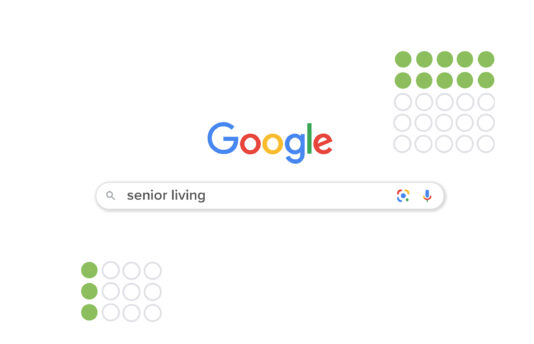No matter your industry, a strong digital media presence is crucial is to your marketing strategy, and staying ahead of the quickly evolving curve is key to success. To help you keep up, we’ve collected three of the hottest digital marketing trends you can’t afford to miss—and a couple of the not-so-hot to keep in mind.
What’s Hot
1. Google Business Profiles
While algorithms change, Google’s own Google Business Profile (formerly Google My Business) continues to be your steadfast ally in local search. Location-based searches (meaning queries with phrases like “near me”) have increased 200% in the last two years, up to over one billion searches in the US alone—that’s a lot of search volume. Optimizing your profile with accurate information, high-quality photos and positive customer reviews increases your visibility and keeps you in Google’s good graces. If Google finds that your profile is relevant to users searching nearby, you’ll show up in both Search and Maps placements—maybe even in the coveted top three, known as the “Local Pack.”
Aside from making sure your profile is claimed and complete, there are other ways to signal to Google that you’re a business worth prioritizing. Answering questions submitted to your profile and regularly posting updates can signal that you’re active and engaged, leading to Google being more eager to connect you with users to whom you could be of value.
2. Google Analytics 4 (GA4)
With Universal Analytics in the rearview mirror, GA4 marks a transformative leap in digital marketing analytics, offering a more robust and privacy-focused approach to your web data. With tons of new functionality, like custom events and machine learning integration, GA4 equips you to be able to make truly data-driven decisions in your marketing. Cross-platform tracking enables you to seamlessly see your audience’s behavior across multiple touchpoints. And that allows you to optimize your strategies for the whole picture. It’s all about the user journey.
Analytics lets you drill down a little deeper, as well. Did users from your newsletter or paid search spend more engaged time on your site? Which group took more valuable actions? And which were more likely to come back? The sooner you start tracking, the sooner you can start to see the whole story for your brand.
3. Artificial Intelligence (AI) Search
AI is rapidly transforming the way we search for information. Search engines like Google are now using AI algorithms to understand user intent and deliver more relevant results. Taking it a step further, AI-generated results are starting to claim the top spot in search results, pushing links further down and keeping traffic on the search engine results page instead of funneling it to relevant pages on another site. This could mean reduced organic traffic to your site, necessitating a pivot in your SEO strategy.
But it’s not all doom and gloom. While AI can work against you on search engines themselves, it can also function as your stalwart ally in refining and redefining how you do SEO. While powerful tools such as SEMRush are integrating AI partners to streamline sophisticated SEO workflows, you can also employ free and accessible AI, such as Gemini or ChatGPT, to help you do some heavy lifting. Try asking your AI of choice to develop a list of what your users might search for. Once you’re happy with your target keywords, have your new SEO assistant help you develop longtail keywords, write SEO content outlines, develop schema mark-ups or just have it check your spelling and grammar. While AI is by no means infallible, it’s more than capable of giving you a hand here—just make sure to double-check your results.
What’s Not
1. Sunset of Cookies (Not Red Hot Yet, Anyway)
Marketers can keep calm and carry on as the era of third-party cookies approaches its end. Google has delayed the phase-out to early 2025, giving businesses more time to adjust.
In the meantime, you can focus on alternative methods for tracking data:
- Zero and First-Party Data: Collect information directly from users through surveys, social media interactions and website analytics.
- Contextual Advertising: Place ads based on the content users are viewing rather than their browsing history.
- Identity Resolution (Consolidated Data Records): Combine data from various sources to create a comprehensive view of the customer.
- Universal ID (by The Trade Desk): Use a standardized ID to track users across different platforms and devices.
- Advanced Machine Learning Algorithms, AI and Predictive Modeling: Employ sophisticated technologies to analyze user behavior and predict future actions.
By respecting user privacy and utilizing these advanced tracking methods, businesses can continue to build strong, trust-based relationships with their audience in a post-cookie world.
2. Geofencing
Geofencing currently falls short of the “hot” status due to its potential inaccuracies and privacy concerns, such as unreliable GPS signals and intrusive tracking (which really defeats its intended purpose). There’s also apprehension about its misuse. However, with effort, time and industry knowledge, you may be able to optimize geofencing for your needs. Start by tailoring strategies to fit your industry and customer persona. Incorporate contextual data and exclusions to enhance accuracy and relevance. Utilize geofencing to drive foot traffic to your brick-and-mortar locations through targeted sales and promotions. Finally, refine your approach with attribution data and modeling for better insights. For now, it seems like there are better, more reliable ways to go about marketing without all these challenges.
By staying on the cutting edge and evolving your digital marketing strategy with the times, you can remain at the front of the pack instead of being left behind.











